How bombweed invaded my brain
A story in three acts, featuring Rosebay Willowherb, the London Underground, and the Rolling Stones
You’re reading The Earthworm, an alternative gardening newsletter that takes a sideways look at the world of gardens, gardening, horticulture and all that good green stuff. If this is your first time here, you can catch up on anything you’ve missed by following this link. Subscribe now for free and join the community or, if you can afford to do so, support my work by upgrading to a paid subscription at any time. Thanks, and enjoy today’s post.
Have you ever experienced that peculiar phenomenon, which I’m going to call “consciousness squatting”? It’s when a name, or an old song, or more often than not a word – one that you had never heard before, or maybe hadn’t thought about in the longest time – suddenly seems to pop up… everywhere, lodging itself in the forefront of your mind.
It happens to me all the time. A couple of days ago, sprawled zombified in front of the TV, I caught a few minutes of an ancient recording of some Rolling Stones gig. Front and centre, Mick Jagger, Keith Richards and Ronnie Wood strode around the stage, pouting and strutting and holding their guitars symbolically perpendicular to their crotches.
Somewhere in the background, meanwhile, barely illuminated by the stage lights, half hidden by Charlie Watt’s drum set, was a po-faced figure getting on with the honest, unshowy business of playing a bass guitar. “Oh yeah,” I thought to myself, “I’d forgotten about Bill Wyman.” I pointed him out to my wife, and we talked briefly about this peripheral figure; the least famous of the Stones. The next morning, there was an article in the Sunday Times: ‘Bill Wyman, the Rolling Stone airbrushed out of history’. Having not thought about Bill Wyman in years, suddenly there he was, popping up twice in a matter of hours, his name dredged from the depths of my consciousness, and implanted firmly in my mind’s eye.
Sometimes you can just write these moments off as curious coincidences. But other times, they can feel more significant, or even revelatory.
That was the case recently with Rosebay Willowherb. For years, I’d barely given this pretty but troublesome weed, this fast-spreading coloniser of disturbed ground, this occupier of railway banks and building sites, a moment’s thought. Then suddenly, I couldn’t ignore it, for all the right reasons.
Act 1. Interior. My living room. Whilst reading Richard Mabey’s excellent ‘Weeds: the story of outlaw plants’ (which I reviewed here), I was fascinated to learn the origin story of one of Rosebay Willowherb’s more evocative common names: bombweed. During the second world war, vast swathes of London were reduced to rubble by German bombs.
In the aftermath of the war, as shellshocked Londoners wandered the ruins of their city, they were met with the eerily beautiful sight of Rosebay Willowherb’s tall, pink-tipped flower spikes, emerging from the dust and ashes, decorating the destruction. The plant’s pioneering occupation of bombsites, which gave it its new moniker, elicited mixed reaction from observers. For some, the flowers spoke to the resilience of life, even in the face of near-total annihilation. For others, the bombweed was an insult, a defilement of their broken civilisation.
Act 2. A couple of days later. Interior. My bedroom. Light creeps in through the shutters. Eyes half open, I reach for my phone and check my inbox. Among the unopened messages, a marketing email from the London Transport Museum shop. The subject line: ‘Parks, gardens and green journeys this summer 🌻🌳’. I open the email and click through.
I was born in London, and have lived here practically my entire life (university term times aside). Cut me, and I bleed London. Take a biopsy from my lungs, and you’ll find tissue blackened by decades of breathing heavily polluted, particulate-dense air. Having said all that, London’s landmarks don’t mean much to me. Big Ben, Buckingham Palace, St Paul’s Cathedral, Trafalgar Square – these iconic buildings leave me cold. The Tube, on the other hand? Now we’re talking.
I’ve always loved the Tube, not only for its practicality, but its aesthetics. I love the seat fabrics; the station mosaics; the graphic, colourful maps; and I love the posters. The old posters, anyway.
At various points during the 20th century, the Tube underwent periods of expansion, sending exploratory tendrils of tunnels and tracks into the then outskirts of London. New Underground stations turned satellite towns into bona fide suburbs. Artists and illustrators were commissioned to create posters which advertised this expansion and promoted a suburban dream: work in the city, but escape to suburbia, where you can sow seeds, mow the lawn, and smell the flowers.
It was thanks to that marketing email from the London Transport Museum that I learned of watercolourist, linocut artist and poster designer Walter E Spradbery. Discovering Spradbery, and his work, made me feel how I imagine genealogy aficionados do when they uncover a little known branch of their family tree. A bridge to the past; a new connection.
Spradbery studied at Walthamstow Art School. I live in Walthamstow! Spradbery was a great admirer of the Arts And Crafts icon William Morris, and played a key role in the creation of Walthamstow’s William Morris Gallery. I love William Morris and the associated gallery! Spradbery was a pacifist, and more to the point, a plant obsessive. We’re practically soul mates! (Or might have been, anyway, if he hadn’t died in 1969.)
In his work for London Transport, Spradbery celebrated not just the glossy, manicured nature spots accessible via the metropolitan rail network – places like Richmond Park and Kew Gardens – but also what we (and his contemporaries) would consider weeds. Wildflowers. Nature untamed. His posters depict brambles, bindweed, and on one from 1936, a charming collection of fairytale-like fungi accompanied by the words “Autumn hues… falling leaves and glories in decay”. Which, considering this was promotional material for a subterranean rail network, is brilliantly weird.
But my favourite of Spradbery’s posters was one he created in 1945, as Londoners began to pick up the pieces of their broken city after the end of World War II. It could have been chest-beaty, celebrating the Allies’ victory or revelling in the Nazis’ defeat, but Spradbery was clearly too classy, too thoughtful for that. His poster was different.
The theme: hope. The message: ‘Renascence’. The subject: Rosebay Willowherb.
Act 3. Exterior. A field near Tetbury, Gloucestershire. On the Sunday morning of a stag do (aka bachelor party) weekend, I found myself on a disc golf course in the grounds of Calcot Hotel & Spa. The hotel sits on a large estate, surrounded by 240 acres of Cotswold countryside, currently the site of a concerted rewilding effort. As we made our way around the disc golf course, we were struck by the beauty of the place. Rolling fields, insects everywhere, and an abundance of shoulder-high, eye-catching flower spikes: an ocean of Rosebay Willowherb, painting the countryside pink.
Rosebay Willowherb. I’d read about it in books; I’d seen it illustrated in post-war propaganda; and now here I was, staring at it, surrounded by it, confronted by its unquestionable loveliness. And so it was that bombweed completed its escape from the recesses of my subconscious, to find a permanent home not just in my memory, but in my heart.
Just not sure I can say the same for Bill Wyman.
What squatters have taken up residence in your consciousness of late? Do you have strong feelings about Rosebay Willowherb? How about Bill Wyman? Leave a comment and let me know. Or if you’re feeling shy and are reading this in your email inbox, just hit ‘reply’.

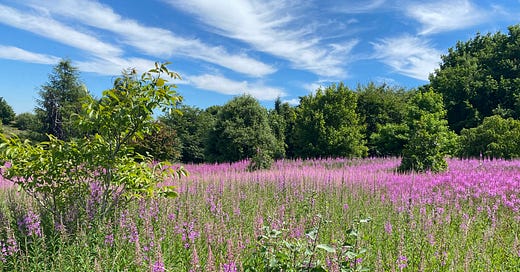



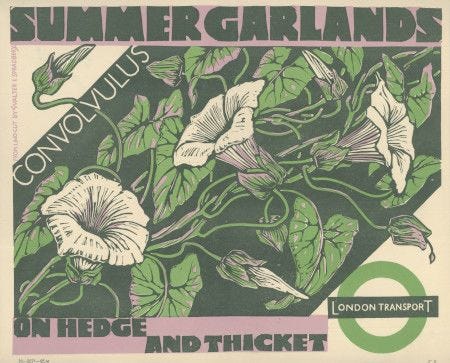

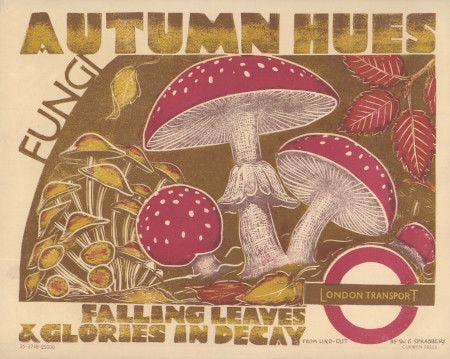
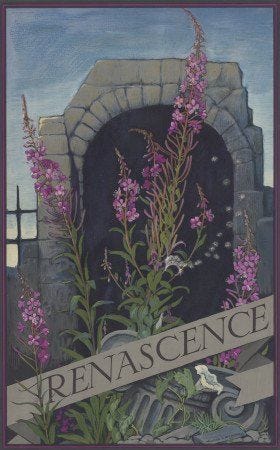
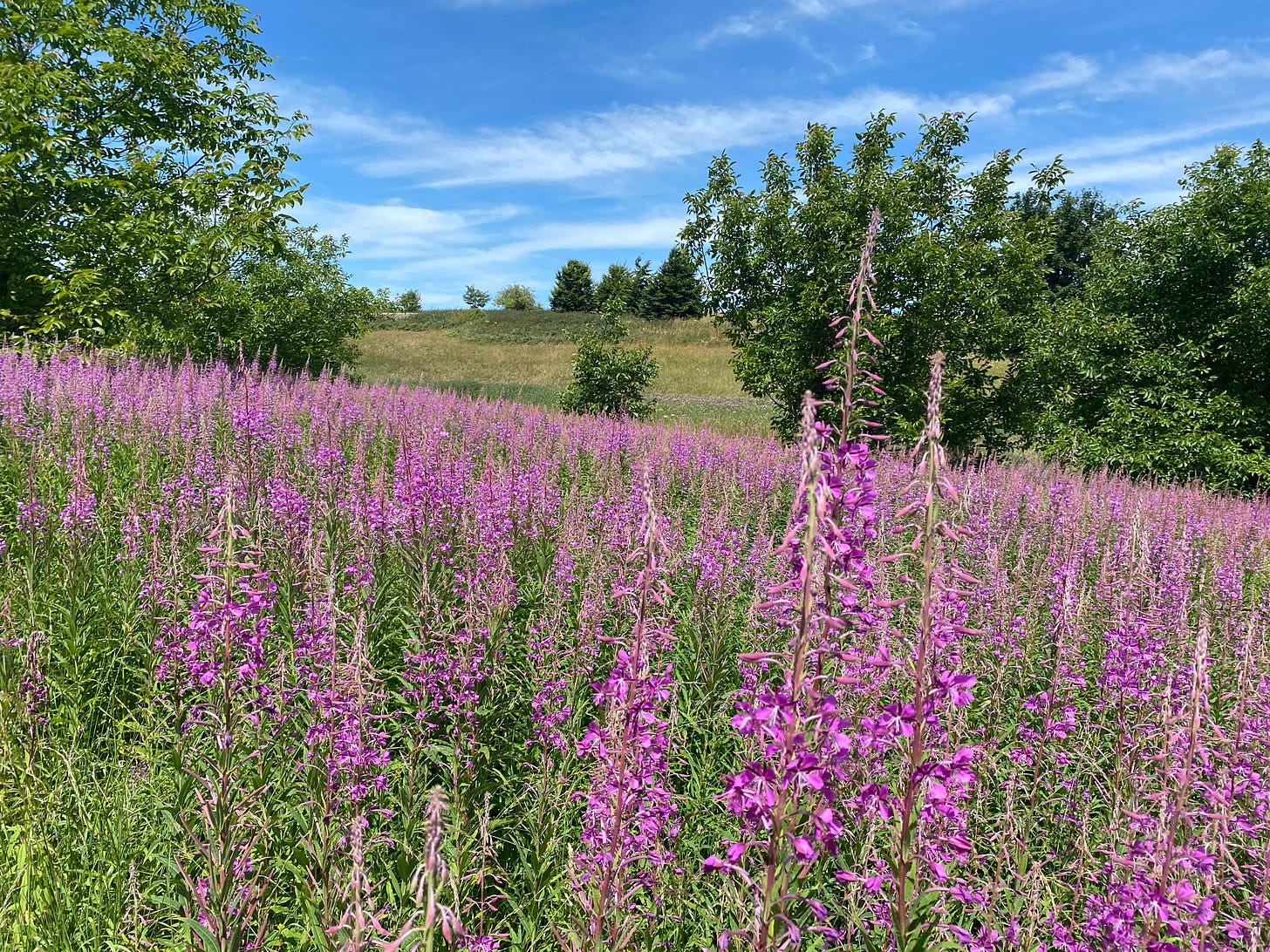
A very Jungian experience, your synchronicities!
Here’s mine...
In 2020, my wife mentioned how it would be nice to have a mulberry tree. The pandemic panic buying made some things unavailable. Mulberry trees was one of them. None of the plant nurseries had any in stock.
2021 was the same no mulberry trees.
2022 and mulberries were back. I ordered a dwarf red. It arrived and in the ground it went.
A few weeks later while preparing a large flower bed for new plantings, I noticed something with the roses. Something growing that wasn’t roses. It was a white mulberry tree.
A bird ate a mulberry somewhere, and planted the very tree I was looking for. It’s size says it’s been growing unnoticed a couple of years.
And a note from Anne in reply to my message on her brand new substack:
“ I have all kinds of rosebay - the pale pink comes first, followed by the white, then the wonderful weed: https://veddw.com/south-garden-wild-garden-headstones/ Love them all.”